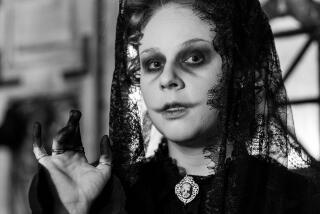Temple of Bafflement
- Share via
Behind the Beverly Hills home that retired Hhughes aircraft exec Jerry Slocum shares with his wife, Margot, is a nondescript building with one distinguishing feature: a geometric wooden thingamajig on the door. It looks like modern art, but it’s really a “Burr puzzle,” whose interlocking rods must be slid out just so for the door to open--a fitting entry to a collector’s lovingly assembled puzzle museum.
Slocum’s love affair with mechanical puzzles began at age 10, with an inexpensive Chinese ring puzzle requiring a lot of patience and a little mathematical derring-do. “After I solved that,” he says, “I was hooked.”
Sixty years later, Slocum’s collection, most of which he purchases from other collectors, dealers and antique stores, includes 27,500 pieces (not counting the 300 to 400 he recently brought back from a puzzle-finding mission in Tokyo, Beijing, Shanghai and Ulan Bator, Mongolia).
Slocum catalogs each puzzle under a dozen or so categories: Put-Together, Take-Apart, Interlocking Solid, Disentanglement, and so forth, a taxonomy he developed about 25 years ago that has become standard among puzzle collectors. The smallest item in the collection is a tiny wooden Burr puzzle less than 1/8 of an inch across; the largest is a set of rosewood Chinese puzzle tables made around 1850. Three feet across when assembled, the set is based on the tangram, a seven-piece puzzle developed in China around 1800, which sparked the first of four worldwide puzzle crazes, says Slocum. The most recent, the Rubik’s Cube craze, caught on in about 1980. Slocum has a few hundred of the cubes, including several designed for blind users
. Although he has not completed every puzzle in his collection, Slocum has worked on most of them. He prefers puzzles with “very simple instructions” that require him to “think in a new way.” Among his most prized possessions are a dozen or so rare puzzle locks, some worth $5,000. “They were used in the early days of banks,” he says, “in the early and mid 19th century.” Puzzle locks have no apparent openings and require a series of tricky manipulations designed to discourage intruders.
Slocum’s museum is open only to friends, family and serious puzzle people. Among the comments they’ve inscribed in the guest book are: “I admire but don’t understand.” “Great place to spend a decade.” And--high praise in the puzzle world--”Inscrutable!”
More to Read
The biggest entertainment stories
Get our big stories about Hollywood, film, television, music, arts, culture and more right in your inbox as soon as they publish.
You may occasionally receive promotional content from the Los Angeles Times.









